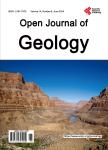Biostratigraphy, Palynofacies and Organic Geochemical Characterization of Three Wells, Western Offshore Niger Delta Nigeria
Biostratigraphy, Palynofacies and Organic Geochemical Characterization of Three Wells, Western Offshore Niger Delta Nigeria作者机构:Department of Geology University of Ibadan Ibadan Oyo Nigeria
出 版 物:《Open Journal of Geology》 (地质学期刊(英文))
年 卷 期:2023年第13卷第5期
页 面:504-535页
学科分类:081803[工学-地质工程] 08[工学] 0818[工学-地质资源与地质工程]
主 题:Biostratigraphy Rock-Eval Palynofacies Infrared Spectroscopy Palynomaceral
摘 要:Ditch samples from AP-4, ER-51 and UK-2 offshore Niger Delta were subjected to biostratigraphic and organic geochemical analyses which entail foraminiferal, palynological, Spore Colour Index (SCI), Rock-Eval Pyrolysis and Fourier Transform Infrared Spectroscopy (FTIR) analyses. The results have established N19 and N17;N17, N16 and N15;and N9 and N8 biozones;and P600 and P700 palynological zones. The dominance of palynomaceral (PM) I and II suggests Type III kerogen. PM III and IV (Type II and IV) were recorded. SCI ranges from 3/4 to 5/6 suggesting an early to mature liquid hydrocarbon generation phase. Rock-Eval Pyrolysis shows that the Total Organic Carbon (TOC), Hydrogen Index (HI), Pyrolysis temperature (Tmax), and Vitrinite Reflectance (VRo) range from 2.48 wt% - 6.37 wt%, 78 - 258, 411°C - 431°C and 0.26% - 0.69% respectively suggesting high TOC of Type II/III kerogen. FTIR indices show Type I kerogen in all the wells. VRo results range from 0.4 - 0.5 indicating an immature source. High concentrations of aliphatic saturates in identified functional groups indicate a low biodegradation. The abundance and diversity of recovered assemblages and dominance of PM I and II suggest shallow depositional environments with an age range of late Miocene to early Pliocene. Palynomaceral, SCI, and Rock-Eval inference contradict FTIR kerogen type suggesting that IR spectroscopy might not be suitable for kerogen typing and origin. The geochemical and biostratigraphical inferences must be corroborated for a successful evaluation. However, the source rock in the study area has adequate organic matter with the prospect to generate both oil and gas at appropriate maturity.



